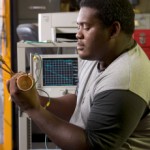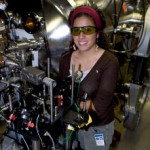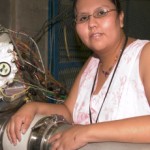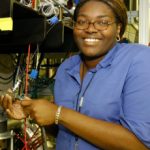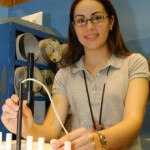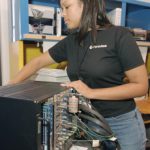Rasheed Auguste, SIST 2015
Rasheed created a web-based tool for manipulating the “Geant 4” simulation application, which he then used for analyzing pion cross sections in a future collider. Read more
Maggie Langfort, SIST 2015
Maggie worked with scientists in the Fermilab Accelerator Division to investigate a second harmonic radio-frequency cavity for the Fermilab Booster accelerator. When this cavity is built, it will lead to higher neutrino fluxes for the experiments at Fermilab. Read more
Shannon Massey, SIST 2015
Shannon worked on data analysis for the CMS experiment at the LHC. He used the Toolkit for Multivariate Analysis (TMVA) for this analysis, in particular, the Artificial Neural Network methods within TMVA. Shannon examined the implementation of multilayer perceptrons to classify Z→μμ decay data and Drell-Yan process data. Read more
Andre Merrile, SIST 2013
During his summer at Fermilab, Andre helped to build a multi-sample probe capable of testing the critical current of superconducting materials. The critical current is the maximum current that can be passed through a material while it remains superconducting. With much help he was able to assemble the probe and commission it for room temperature and liquid nitrogen tests. Read more
Didier Muvandimwe, SIST 2013
Didier worked on the mechanical integrity of the NOvA Far Detector. He used a graphical program called Synoptic to display strain and distance readings within this detector. These displays provide a quick and convenient way of reading out these data in the control room of NOvA. Read more
Rene Nsanzineza, SIST 2013
Rene worked on a project designed to study dark matter in the laboratory using the Compact Muon Solenoid (CMS) detector at the LHC in Geneva, Switzerland. He used Monte Carlo simulation to find a good way to separate dark matter events (signal) and other events (background) produced inside the CMS detector. Read more
Juan Reyes Gonzalez, SIST 2013
Juan’s used computer-aided design (CAD) 3D modelling, computerized analysis and experimental testing in an investigation of the components of the Single Spoke Resonator (SSR1), for the High-Intensity Neutrino Source (HINS) at Fermilab. He developed several CAD models of the critical aspects of this delicate structure. Read more
Margo Batie, SIST 2012
Margo investigated the merits of three different types of RF cavities that could be used in the g-2 Experiment: Using a computer program for evaluating RF Cavities with Cylindrical Symmetry, various cavities were modeled to examine the accuracy of measurements and calculations of previously fabricated cavities. Margo will use this knowledge and experience in pursuing a Physics PhD. Read more
Andrea Delgado, SIST 2012
The next generation of detectors calls for an increase in resolution, a deep understanding on the processes in which particle detection occurs as well as an affordable design that does not compromise the performance of these devices. This project is a detailed study of the sources of fluctuation that affect the resolution of a calorimeter and proposes a Homogeneous Total Absorption Dual Readout calorimeter a correction to these fluctuations. Read more
Jared Knutt, SIST 2006
The Linear Accelerator at Fermilab accelerates negative Hydrogen ions to the Booster. In order to facilitate the acceleration process, Radio Frequency energy is used and is produced by Klystrons. Jared investigated heat transfer in fast ferrite phase shifters, to be used in the Linac. Read more
Michelle Alvarado, SIST 2005
In order to guarantee that the beam that reaches the user experimental area carries with it stable properties, part of the beam is sent to a diagnostics table to be analyzed. Two instruments are set up to characterize the beam’s pulse width and bandwidth in the time and frequency domain. Read more
Trivia Frazier, SIST 2005
The goal of this experiment is to find a target material more suitable for the proposed multi-mega-watt 8-GeV proton driver and booster system, which uses multiturn charge-exchange injection. Preparation includes tuning bending and quadrupole magnets and doing calculations of pertinent theoretical values, such as instantaneous current density and average power. Read more
Linda M’mayi, SIST 2005
The purpose of the website / database subproject was to create a website that would serve as a user-friendly interface to an underlying database such as a MySQL database, therefore allowing Program Support staff to easily manipulate data in the database via the web as opposed to having to do so directly in the database itself. Read more
Ernestine Chaco, SIST 2004
Modulation affects the quality of the ion beam extracted from an ion source. A decrease in modulation has been found in a Penning source by adding small amounts of nitrogen gas. The focus of this project is to improve the stability of the magnetron ion source through the use of a hydrogen-nitrogen gas mixture. Read more
Courtney Boykin, SIST 2003
In the Recycler Electron Cooler, a method for monitoring the beam’s profile for diagnostic information was desired. To achieve this goal, the idea of using the flying wire was conceived. First, stable PID control of the wire had to be obtained. Read more
Tsatsu Nyamadi, SIST 2003
Recently a new and less expensive technique for the production of an electron beam with a high transverse emittance ratio, a “flat beam”, has generated substantial interest. This is because flat electron beams enable high luminosity with small space charge effects at the collision point. Read more
Angelica Perez-Andujar, SIST 2003
Wedge Factor measurements were performed for the wedges that are used at the Neutron Therapy Facility for cancer neutron therapy. Wedge factors enable the calculation of the amount of beam that is necessary to deliver the required dose for treatments that use wedges. For the measurements an ionization chamber was positioned at different depths in a polyethylene phantom. Read more
Lawrence Short Bull, SIST 2003
At Fermilab, beam diagnostics play a crucial role in the operation of the accelerators. These systems allow one to perceive what properties a beam has and how it behaves within the machine. Read more
Pedro Berges, SIST 2002
The method developed in IDEAS to analyze the piping system to be used for the Main Injector Neutrino Oscillation Search (MINOS) experiment and the results obtained with it are presented. This paper includes a thorough description of the finite element (FE) model generated to analyze the system. Read more
Stacy Nordt, SIST 2002
The objective of this project was to convert a Visual C++ program into a LabView program. The LabView program was used to test the 2280 system for accurate channel data and develop various charts to output the data received. Read more










